tundra

Norway lemmings have a 4-year a cycle of abundance (A). A small population can, under favorable conditions, build up to great numbers. These attract predators, but lemmings continue to multiply and deplete their food source. Popularly supposed to commit mass suicide, many lemmings die through attempting to migrate. They may drown while crossing rivers or when they reach the sea. A few remain to restart the cycle. Yearly lemming activity (B) is above and below the snow.
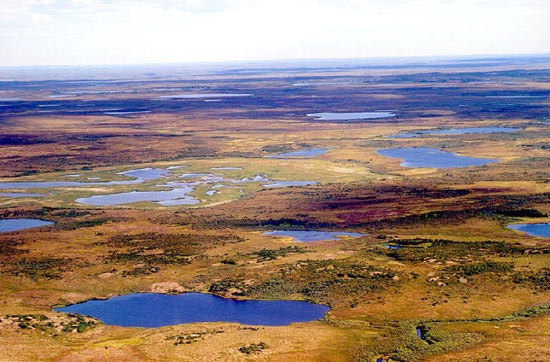
Figure 1. Siberian tundra.

Figure 2. The ground surface of the tundra thaws in summer but stays waterlogged as the permafrost impedes drainage (A). In winter it freezes, but small mammals (B) survive in burrows.
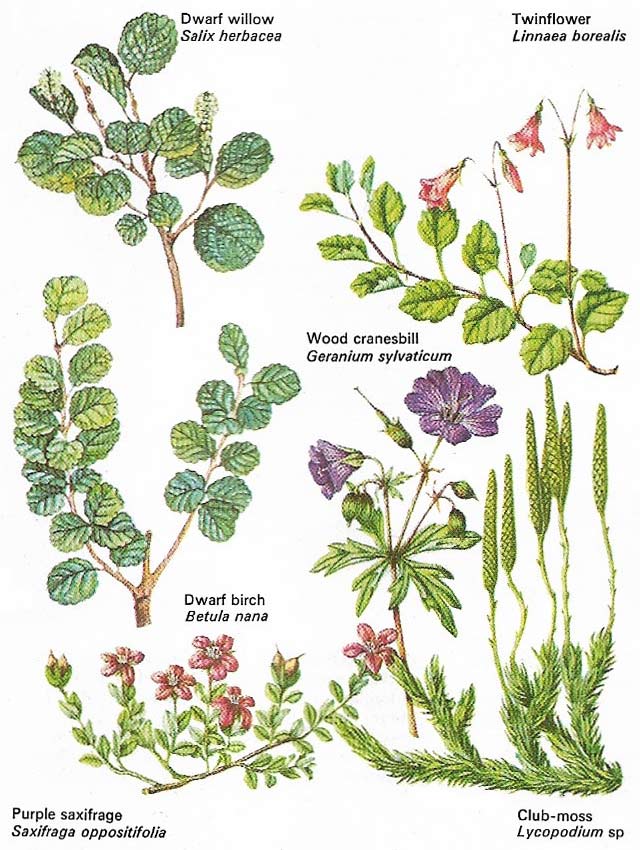
Figure 3. The vegetation of the tundra is almost all prostrate. A dwarf birch that grows up to 1 meter (39 inches) high is exceptional. Usually this plant is smaller, as are dwarf willows, even when they are mature "trees". Beneath birch and willow is a rich growth of mosses and lichens which form the equivalent of a shrub layer in a temperate forest. Here Lycopodium, a club-moss, is found. This small plant may spread over the ground for many hectares, but is a poor reminder of the great scale trees of the past to which it is closely related. The wood cranesbill is one of the brilliant summer flowers of the tundra. Purple saxifrage is also found on many southern mountains, forming part of a flora referred to as "arctic alpine". Linnaea commemorates the great Swedish botanist Carl Linnaeus, who made a journey to the tundra of Finland.
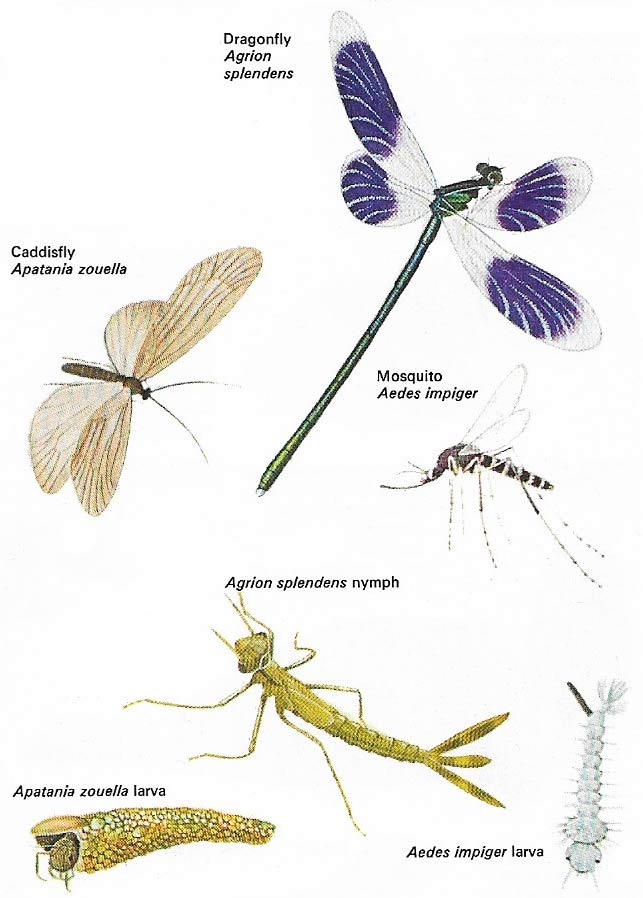
Figure 4. Most tundra insects spend their larval lives in the ephemeral pools of the summer and can survive the winter in moist conditions under the ice. Many feed on bird and mammal blood.

Figure 5. Small waders, such as dunlin, turnstone, and knot, migrate north each spring to nest in the tundra. Like them, long-tailed duck and brent geese return south to feed on mudflats and estuaries once their families are reared. The snowy owl is a resident but moves slightly south in the hardest of weather.
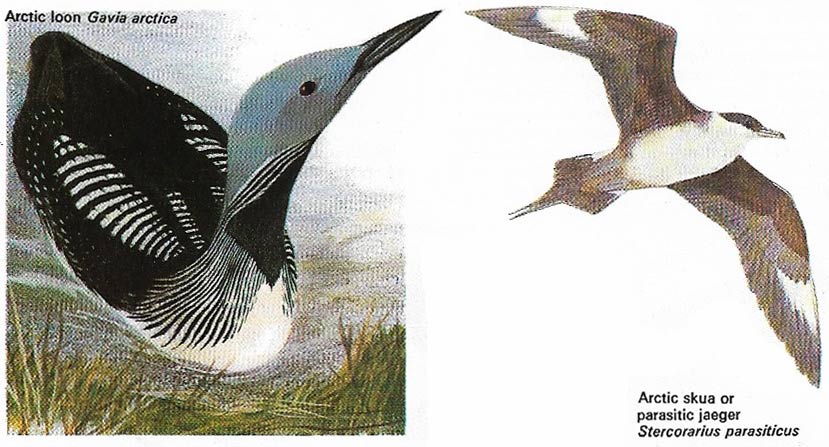
Figure 6. Both skuas and loons breed on the tundra but they migrate to the oceans in winter. The arctic loon or black-throated diver feeds on fish. The skua eats voles and lemmings or fish it steals from gulls.
Tundra (from the Finnish for a treeless plain) is a treeless, level or gently undulating plain characteristic of Arctic and sub-Arctic regions (Figure 1). The main swathe of tundra occurs in the Northern Hemisphere, running across northern Canada and Eurasia, between 60° and 70°N latitude. About three-quarters of the plant and animal species are common to tundra everywhere.
For most of the year the temperature is than 0°C, and even during the short summer it never (until recently, due to climate change) rises above 10°C (50°F). During winter, temperatures can fall to –30°C ( –86°F). For six to nine month the average temperature is below freezing point, and there is a thick layer of permafrost, of which only the top few centimeters thaw out in the summer. Where melting occurs, the land is wet and marshy, an ideal breeding ground for mosquitoes. The wet tundra soils are gleys, and waterlogging is characteristic. Tundra vegetation includes lichens, mosses, stunted shrubs, and, in summer, small flowering plants.
Similar regions on high mountains (but generally without permafrost) are called alpine tundra.
Harsh climatic conditions
Within the tundra, darkness and cold are the two factors that act as the principal controls on life. At the Arctic Circle the Sun does not rise above the horizon at the winter solstice, and north of the circle the darkness is more prolonged. Over much of the tundra there is no sunlight for several months of the year. This is compensated for, to some extent, by the continuous daylight of summer, but the plants and animals cram much of their activity into this short period of light.
The cold is equally important and part of the geological inheritance. The subsoil is totally frozen, a condition known as permafrost. It is at least 610 meters (2,000 feet) deep in Greenland and may be deeper in other places. Only the surface soil thaws in summer. This is known as the active zone and may be as deep as 3 m (10 ft), or as shallow as 7.6 centimeters (3 inches), but in either case it supports all life in the area, both plant and animal. Yet the soil in it is likely to be waterlogged because water cannot drain through the frozen zone. The frequent freezing and thawing causes the soil to rise in small blisters, and stones collect in the hollows between them. The resulting formations are known as polygons and stone rings. Such precipitation as there is almost all falls as snow, equivalent to at most 50.8 centimeters (20 inches) of rainfall a year.
There are some high mountains in the tundra, but mostly the land is low-lying, dotted with little lakes and pools and crisscrossed by small meandering rivers. In the "low arctic" of the southern tundra, plant cover may be complete; farther north in the "high arctic" strong winds may sweep away the scanty soil and rooted plants become restricted to crevices and sheltered places. Lichens may be the only plants visible.
Tundra food chains
The larger plants of the tundra are mostly woody, forming knee-high forests of birch and willow, with mature trees often only a few inches high (Figure 3). Many members of the heather family are present. Most of these are berry-beaters and form an important part of the diet of many tundra animals – even the polar bear will gorge itself on cranberries in the autumn. The woody plants are augmented and often overgrown by herbaceous plants, which in the summer provide a brief blaze of color, dying as winter nears.
The animal life of the tundra is surprisingly rich for an environment that seems so inhospitable. Large animals include the musk ox and in the summer the reindeer (caribou in North America). Among smaller predators are wolves, arctic foxes, and wolverines, which feed mainly on the arctic ground squirrel, voles, and the lemmings. These mammals are adapted to the cold with thick, warm fur, and , under the skin, a heavy layer of fat. The danger of frostbite to their extremities is reduced by their compact shape and their short faces, ears, and tails.
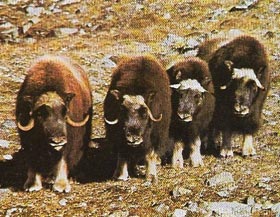 |
| Musk oxen (Ovibos moschatus) are the largest animals found in northern Canada and Greenland. They have disappeared from the Old World, which they inhabited in the Ice Age. Their extremely thick coats protect them from the cold, but they become exhausted if they have to cross thick snow in search of food. If threatened, the herd bunches together, presenting lowered heads and heavy horns to the attacker – providing a good defence against wolves. |
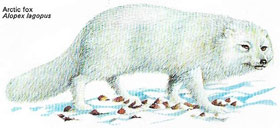 |
| The arctic fox is a circumpolar tundra resident. It exists in two forms: the blue form which is smoky gray all the time, and the brown form which changes to white in the winter. The population fluctuates with the availability of food, following the rise and fall of lemming numbers. |
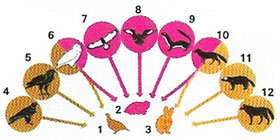 |
| The herbivorous ptarmigan (1), lemming (2), and arctic hare (3) are the principal prey of a range of predators, such as the gyr and peregrine falcons (4, 5), short-eared owl (6), rough-legged buzzard (7), pomarine skua (8), stoat (9), arctic fox (10), wolverine (11), and wolf (12). Because the predators tend to be nomadic, wandering from poor areas to richer ones, there is not much danger of their food becoming scarce. |
Migratory birds
Few birds are resident in the tundra, but every year, drawn by the migratory urge, millions of ducks, geese, and waders (Figure 5), among others, travel to the far north to nest and feed. This is the time of plenty for the arctic fox, which haunts the bird colonies, taking what it can of weak or injured chicks. Those that it cannot eat it hides and some of these caches remain, frozen, as supplies for the winter. The basis for much of the bird life on land is the abundance of insects, including mosquitoes and other biting flies (Figure 4).
The sea is as rich as the land is poor and the summer flush of plankton supports a huge web of life, including seals, whales and seabirds (Figure 6) most of which migrate to the far north to feed on the abundance of the waters. For a short time the temperature rises and activity and life abound. By August, however, the hours of daylight have become noticeably shorter, the temperature drops and the first sleet heralds the winter. Insects die, leaving their eggs and larvae to winter beneath the ice covering the pools or in the shelter of snow-covered vegetation. The birds, their reproductive mission complete, fly southward in great flocks to spend the winter months in temperate and subtropical areas. Reindeer and caribou, followed by the wolves, migrate south, leaving only the musk oxen and the hardy arctic fox.
Yet even in summer the tundra, for all its apparent abundance, is an area where species are few but populations are large, and where the delicate balance of predators and prey is easily upset. Wildlife populations, often made up of prey such as small mammals, may fluctuate wildly between superabundance and paucity. The lemmings are the best known of the animals that undergo this population swing, but they are by no means the only species to do so.


